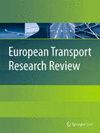评估城市交通模式对都柏林空气污染排放的影响:使用谷歌项目空气视图数据和交通数据的回归模型
IF 4.2
3区 工程技术
Q1 TRANSPORTATION
引用次数: 0
摘要
空气污染是城市地区重大而紧迫的环境和公共卫生问题,主要由道路交通造成。通过深入了解交通动态如何影响空气污染,政策制定者和专家可以设计有针对性的干预措施来解决这些关键问题。为了分析这种关系,我们利用谷歌项目空气视图(GPAV)和都柏林市的 SCATS 数据开发了一系列回归算法,并将距离和天气等各种时空特征考虑在内。分析表明,在空气质量预测方面,高斯过程回归(GPR)的性能大多优于支持向量回归(SVR),这强调了高斯过程回归的适用性以及在建模中考虑空间变化的重要性。该模型对颗粒物(PM2.5)排放数据的描述效果最佳,根据 GPR 模型,在距离研究区域中心的特定距离上,R 平方(R2)值从 0.40 到 0.55 不等。研究区域污染物浓度的可视化还显示了与交叉口之间距离的关联。虽然预期的车辆交通与空气污染之间的直接相关性并不明显,但它强调了城市排放的复杂性和影响空气质量的多种因素。这一启示突出表明,在制定政策时需要采取多方面的方法,确保干预措施能解决交通以外的更广泛的排放源。这项研究推进了当前对城市交通与空气污染之间动态关系的认识,其研究结果可为适用于全球城市中心的交通规划和交通控制提供理论支持。本文章由计算机程序翻译,如有差异,请以英文原文为准。
Evaluating the impact of urban traffic patterns on air pollution emissions in Dublin: a regression model using google project air view data and traffic data
Air pollution is a significant and pressing environmental and public health concern in urban areas, primarily driven by road transport. By gaining a deeper understanding of how traffic dynamics influence air pollution, policymakers and experts can design targeted interventions to tackle these critical issues. In order to analyse this relationship, a series of regression algorithms were developed utilizing the Google Project Air View (GPAV) and Dublin City’s SCATS data, taking into account various spatiotemporal characteristics such as distance and weather. The analysis showed that Gaussian Process Regression (GPR) mostly outperformed Support Vector Regression (SVR) for air quality prediction, emphasizing its suitability and the importance of considering spatial variability in modelling. The model describes the data best for particulate matter (PM2.5) emissions, with R-squared (R2) values ranging from 0.40 to 0.55 at specific distances from the centre of the study area based on the GPR model. The visualization of pollutant concentrations in the study area also revealed an association with the distance between intersections. While the anticipated direct correlation between vehicular traffic and air pollution was not as pronounced, it underscores the complexity of urban emissions and the multitude of factors influencing air quality. This revelation highlights the need for a multifaceted approach to policymaking, ensuring that interventions address a broader spectrum of emission sources beyond just traffic. This study advances the current knowledge on the dynamic relationship between urban traffic and air pollution, and its findings could provide theoretical support for traffic planning and traffic control applicable to urban centres globally.
求助全文
通过发布文献求助,成功后即可免费获取论文全文。
去求助
来源期刊

European Transport Research Review
Engineering-Mechanical Engineering
CiteScore
8.60
自引率
4.70%
发文量
49
审稿时长
13 weeks
期刊介绍:
European Transport Research Review (ETRR) is a peer-reviewed open access journal publishing original high-quality scholarly research and developments in areas related to transportation science, technologies, policy and practice. Established in 2008 by the European Conference of Transport Research Institutes (ECTRI), the Journal provides researchers and practitioners around the world with an authoritative forum for the dissemination and critical discussion of new ideas and methodologies that originate in, or are of special interest to, the European transport research community. The journal is unique in its field, as it covers all modes of transport and addresses both the engineering and the social science perspective, offering a truly multidisciplinary platform for researchers, practitioners, engineers and policymakers. ETRR is aimed at a readership including researchers, practitioners in the design and operation of transportation systems, and policymakers at the international, national, regional and local levels.
 求助内容:
求助内容: 应助结果提醒方式:
应助结果提醒方式:


